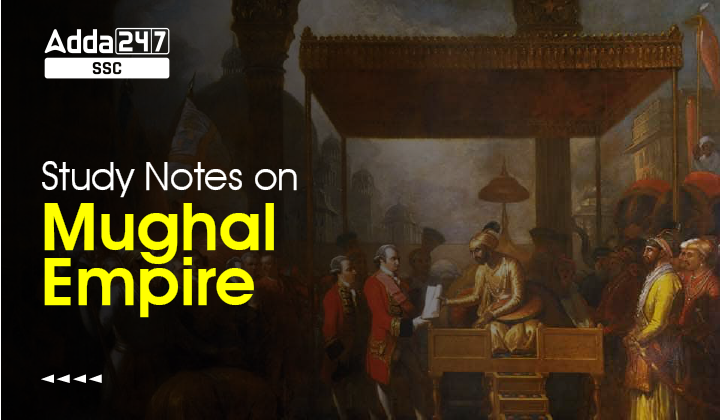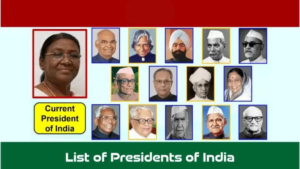Table of Contents
Mughal Empire
The Mughal dynasty is an iconic chapter in the history of India, celebrated for its grandeur, cultural amalgamation, and profound influence on the Indian subcontinent. It was a Muslim Dynasty of Turkic-Mongol origin that ruled most part of the northern India from the early 16th to the mid-19th century. The Mughal dynasty was founded by Babur (who ruled from 1526-1530). He was a Chagatai Turk prince and a descendant of the Ottoman conquerors Timur (Tamerlane) on his father’s side and Genghis Khan on his mother’s side. Let us now learn about the Mughal Empire in detail below.
Mughal Empire: Key Details
In almost every competitive exam where History is asked in the General Awareness section, The Mughal Empire is one of the most asked and repeated topics. So it becomes necessary for the candidates preparing for such exams to have a basic idea regarding the same. The key details of the Mughal Dynasty including the time period, language, religion, capital, etc. are tabulated below.
| Name | Mughal Dynasty Or Mughal Empire |
|---|---|
| Period | 1526- 1857 AD. |
| Common Language | Persian (Official and court language), Urdu (later given official status), Chagatai (spoken in the initial years), Arabic (for religious ceremonies) and other Indian languages |
| Religion | Sunni Islam (Hanafi) (1526-1857), Din-i Ilahi (1582-1605) |
| Capital |
|
| Government | Unitary absolute monarchy under a federal structure
|
| Currency | Rupee, Taka and Dam |
Rulers of the Mughal Dynasty
There were many rulers in the Mughal Dynasty, each different from the other. Going through the attributes of the important Mughal Rulers will provide the readers an idea of the empire as a whole. Check out the table below to learn about the succession of rulers in the Mughal dynasty, spanning from Babur’s reign in the 16th century to Bahadur Shah II’s rule in the mid-1800s.
| Emperor | Reign |
|---|---|
| Babur | 1526–1530 |
| Humayun | 1530–1540 |
| Suri Dynasty | 1540-1555 |
| Humayun | 1555–1556 |
| Akbar | 1556–1605 |
| Jahangir | 1605–1627 |
| Shah Jahan | 1627–1658 |
| Aurangzeb | 1658–1707 |
| Bahadur Shah I (also known as Muazzam/Shah Alam) | 1707–1712 |
| Jahandar Shah | 1712–1713 |
| Furrukhsiyar | 1713–1719 |
| Rafi UL-Darjat | 1719 |
| Rafi Ud-Daulat | 1719 |
| Nikusiyar | 1719 |
| Muhammad Ibrahim | 1720 |
| Muhammad Shah (also called Rangeela) | 1719–1720; 1720–1748 |
| Ahmad Shah Bahadur | 1748–54 |
| Alamgir II | 1754–1759 |
| Shah Jahan III | 1759 |
| Shah Alam II | 1759–1806 |
| Akbar Shah II | 1806–1837 |
| Bahadur ShahII | 1837–1857 |
List Of Mughal Emperors
The Mughal Dynasty was established by Babur and the last ruler of the dynasty was Bahadur Shah Zafar II. The power after the Mughal Empire was transferred to the hands of the British. Here we provide you a complete list of Mughal Emperors, which is very helpful in making notes for your exam preparation.
Babur (1526–1530)
- Babur was born in 1483 in Fargana(Afganistan).
- He was the founder of the Mughal Empire, who introduced gunpowder in India.
- Babur defeated Ibrahim Lodhi in the First Battle of Panipat (AD 1526)
- Defeated Rana Sanga (Sangram Singh) at the Battle of Khanwa (AD 1527)
- Defeated Medini Rai of Chanderi at the Battle of Chanderi (AD 1528)
- Defeated Mahmud Lodi at the Battle of Ghagra (AD 1529). This was the last Battle fought by Babur.
- He wrote Tuzuk-i-Baburi (Autobiography of Babur) in the Turkish language.
- Babur declared Jehad and adopted the title, Ghazi(After the Khanva War)
- According to Tuzuk-i-Baburi, Babur Died in 1530 in Lahore and was buried at Aram Bagh (Agra). Later his body was taken to Afghanistan (Kabul).
Humayun (AD 1530-1556)
- Humayun was born on March 6, 1508, in Kabul, Afghanistan.
- Humayun was the eldest son of Babur. He ascended to the throne of the Mughal Empire in 1530 after the death of his father.
- Built Dinpanah in Delhi as his second capital.
- Sher Shah Suri gradually gained power. He fought two battles with Humayun – The battle of Chausa (AD 1539) and another Battle of Kannauj (AD 1540) culminating in Humayun’s defeat.
- Humayun spent 15 years in exile. He again invaded India in 1555 with the help of his officer Bairam Khan.
- Humayun died in AD 1556 due to a fall from his library building’s stairs.
- Gulbadan Begum, Humayun’s half-sister wrote Humayun-Nama.
Humayun Biography, Second Mughal Empire (Click here to Check)
Akbar (AD 1556-1605)
- Abu’l-Fath Jalal-ud-din Muhammad Akbar popularly known as Akbar succeeded Humayun, under a regent, Bairam Khan, who helped the young emperor expand and consolidate Mughal domains in India.
- Considered to be one of the greatest rulers of all time.
- Defeated Hemu at the Second Battle of Panipat (AD 1556) with the help of Bairam Khan
- Conquered Malwa (AD 1561) defeating Baz Bahadur followed by Garh-Katanga (ruled by Rani Durgawati), Chittor (AD 1568), Ranthambhor, and Kalinjar (AD 1569), Gujarat (AD 1572), Mewar (Battle of Haldighati, AD 1576 Akbar and Rana Pratap), Kashmir (AD 1586), Sindh (AD 1593) and Asirgarh (AD 1603).
- Buland Darwaza was constructed at Fatehpur Sikri after its victory over Gujarat in AD 1572.
- Akbar married Harka Bai (also known as Jodha Bai), the daughter of Rajput ruler Bharmal.
- Akbar abolished Jaziyah (AD 1564).
- He believed in Sulh-i-Kul (peace to all), built Ibadat Khana (Hall of prayer) at Fatehpur Sikri; issued ‘Degree of Infallibility (AD 1579); formulated religious order Din-i-Ilahi (AD 1582). Birbal was the first to embrace it.
- The land revenue system was called the Todar Mal Bandobast or Zabti System measurement of land, classification of land, and fixation of rent; and introduced the Mansabdari System (holder of rank) to organize nobility and army.
- The Navratnas included Todar Mal, Abul Fazal, Faizi, Birbal, Tansen, Abdur Rahim Khana-i-Khana, Mullah-do-Pyaza, Raja Man Singh and Fakir Aziao-Din.
- Akbar died on 27 October 1605 due to dysentery. His body was buried at his mausoleum in Sikandra, Agra.
Jahangir (AD 1605-1627)
- During Jahangir’s rule, the British East India Company was granted trading rights in India.
- Executed the fifth Sikh guru, Guru Arjun Dev.
- His greatest failure was the loss of Kandahar to Persia in AD 1622.
- Jahangir married Mehr-un-Nisa in AD 1611 and conferred the title of Nurjahan on her.
- He established Zanjir-i-Adal at Agra Fort for the seekers of royal justice.
- Captain Hawkins and Sir Thomas Roe visited his court.
- In the later years of his rule, Jahangir’s health declined, and his son Khurram (Shah Jahan) effectively took over the administration.
- Jahangir passed away on October 28, 1627, in Rajauri, while on his way to Kashmir.
Shahjahan (AD 1628-1658)
- Shahjahan had an insatiable passion for building
- Under his rule, the Taj Mahal of Agra and the Jama Masjid of Delhi, among other monuments, were erected.
- His reign marked the cultural zenith of Mughal rule.
- His military expeditions brought the empire to the brink of bankruptcy.
- His sons commanded large armies on different fronts.
- During his reign, the Marwari horse was introduced.
- The Taj Mahal, the eternal love monument is located in Agra. Shah Jahan commissioned its construction as a mausoleum for his favorite wife, Arjumancl Bano Begum, better known as Mumtaz Mahal, in 1631.
- A rebellion of the Sikhs led by Guru Hargobind took place. Shah Jahan ordered the destruction of the Sikh temple in Lahore.
Aurangzeb (Alamgir) (AD 1658-1707)
- Aurangzeb was the son of Mumtaz and Shahjahan.
- Aurangzeb became victorious after the brutal war of succession between his brothers Dara, Shuja, and Murad.
- Rebellions during his rule – Jat Peasantry at Mathura, Satnami peasantry in Punjab, and Bundelas in Bundelkhand.
- The annexation of Marwar in AD 1658 led to a serious rift between the Rajput and Mughals after the death of Raja Jaswant Singh.
- The ninth Sikh Guru, Guru Tegh Bahadur was executed by him in AD 1675.
- Mughal conquests reached a territorial climax during his reign.
- It stretched from Kashmir in the North to Jinji in the South, from the Hindukush in the West to Chittagong in the East.
- He was called Darvesh or Zinda Pir. He forbade Sati. Conquered Bijapur (AD 1686) and Golconda (AD 1687) and reimposed Jaziya in AD 1679.
- He built Biwi ka Makbara on the tomb of his queen Rabaud-Durrani at Aurangabad; Moti Masjid within Red Fort, Delhi; and the Jami or Badshahi Mosque at Lahore.
- Aurangzeb died in 1707 in Ahmednagar.
Other Mughal Rulers
After the death of Aurangzeb, there was a clear decline in the Mughal’s command over the empire. However, there were some rulers who tried to restore the glory of the empire. Some historians have called this period the time of the ‘Later Mughals’. Let us have a look at the next stage of the Mughal Empire
Bahadur Shah I (1707-12)
- The original name was Muazzam
- Title, Shah-e-Bekhabar.
- Promote a friendly relationship with Marathas and Rajputs
Jahandar Shah (1712-13)
- He ascended the throne with the help of Zulfikar Khan (Wazir).
- Abolished Jijiya.
- A Prostitute “LAL KUAR” dominated his court
Farrukhsiyar (1713-19)
- He lacked the ability and knowledge to rule independently.
- His reign saw the emergence of the Sayyid Brothers (known as kingmakers).
- Abdulla Khan-Wazir
- Hussain Ali-Senapati
- 1717-Issued Golden Farman to East India Company for free trade
- Farrukhsiyar executed Banda Bahadur ( A Sikh leader)
Muhammad Shah (1719-48)
- Became the emperor with the help of the Saiyad Brothers
- Nadir Shah invaded India and took away the Peacock throne and Kohinoor diamond.
- Title- Rangeela
- The emergence of the independent state in his period
Ahmed Shah (1748-54)
- Ahmed Shah Abdali (General of Nadir Shah) marched towards Delhi and the Mughals ceded Punjab and Multan.
- He worked under the guidance of Rajmata “Udam Bai”
Alamgir (1754-59)
- Ahmed Shah occupied Delhi Later, Delhi was plundered by Marathas.
Shah Alam II (1759-1806)
- Original NAME: Aligohar
- Panipat War: (1761)
- Buxar War (1764)
- Treaty of Allahabad (1765)
- Could not enter Delhi for 12 years.
- 1788: Gulam Kadir make him blind
Akbar II (1806-37)
- Pensioner of East India Company.
- Gave the title “Raja” to Ram Mohan Roy
Bahadur Shah II (1837-57)
- Nickname: Jafar
- The last Mughal Emperor was made premier during the 1857 Revolt.
- 1862-death in Rangoon (Myanmar)
Fall of the Mughal Empire
Historians have offered numerous explanations for the rapid collapse of the Mughal Empire. Emperors lost authority and control of the empire, as the widely scattered imperial officers lost confidence in the central authorities, and made their deals with local men of influence. The successors were weak and incompetent. Another reason is the multiple wars that were fought in quick succession. Due to this Marathas and other regional powers started to grow and made it difficult for the Mughals to control their empire. The decline of the Mughal Empire led to a decline in agricultural productivity, which drove up food prices.
Mughal Empire – Rulers, Fall of Empire and Complete Details PDF
Candidates can download the detailed pdf regarding Mughal Empire – Rulers, Fall of Empire, and Complete Details from the link provided below.
Click here to download Mughal Empire – Rulers, Fall of Empire, and Complete Details PDF
























 States and Capitals in India, List of 28...
States and Capitals in India, List of 28...
 List of Presidents of India from 1950 to...
List of Presidents of India from 1950 to...
 National Parks of India, Check Full List
National Parks of India, Check Full List


